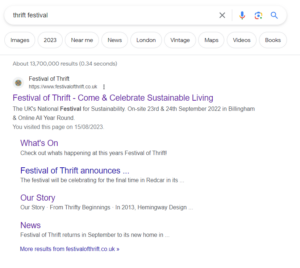
Beginner Read Social Media
Social media is a unique and powerful way to help your organisation thrive and engage with your audience. Read on to find out more.
In this article
In this article we explain what Google Ad Grants is and how to make the most of it in your organisation.
The Google Ad Grants programme gives charities the opportunity to reach audiences who are actively seeking information about their cause, using free Google Ads advertising credit.
Ad Grants allows organisations to use the same Google Ads platform that millions of commercial businesses pay to use, but as non-profits they can access a free advertising credit of $329 (USD) per day, which is equivalent to about $10,000 (USD) per month.
There are no application deadlines and organisations are assessed on a series of criteria (like being a registered charity) and never competing against each other for the grant. There is also no need to periodically re-apply for the grant; as long as your account is in good standing, the grant will continue indefinitely.
In order to be eligible for Google Ad Grants you need to be a registered charity (with a charity number) and you cannot be a government organisation, a hospital, a healthcare organisation or a school, academic institution or university. In other words, if you are charity operating in the cultural sector, you are likely to qualify.
In principle, Google Ad Grants are not meant to be used in ‘for-profit’ activities, but if your shop or events you organise are there to support your charity’s mission, you are allowed to promote them using Ad Grants.
Here is a comprehensive and resource-rich video on how to apply for Google Ad Grants. The Google Non-Profits partner in the UK is Charity Digital.
Not to look a gift horse in the mouth, but when you get into the details of Google Ad Grants, you may find that they are not what they appeared to be. There are firm limitations to what you can do with them in comparison to a paid Google Ads account.
Unlike Google Ads, which offer you a whole array of advertising choices, Ad Grants only allows you to advertise a link to your website on Google Search Engine Results Page (SERP). You have no access to Google Display Network – i.e., advertising on other websites – or re-targeting features. Re-targeting allows you to “chase” your visitors on the internet, displaying your targeted ads to people who have already visited your website. This can be very useful for increasing abandoned transactions, donations, or event sign-ups. To use this feature, you will have to have a paid Google Ads account.
When managing Google Ad Grants budgets, using all of the $10,000 budget to bid on “donate” keywords just won’t work. Unfortunately, Google Ad Grants don’t work like that. Paid ads do not actually compete with Ad Grants. Ad Grants will always appear below paid Google Ads.
This means that if you try to bid for a competitive keyword, such as “donate,” you have no chance of appearing on page one of search results. A big part of your Ad Grants strategy is finding the right keywords to bid on. They can’t be too competitive but still result in valuable traffic to your website.
As mentioned earlier, the overall monthly budget of $10,000 is split into daily allowances of $329. If you don’t spend that amount on the day, it doesn’t roll over to the next day.
Also, there are limits to how much you can bid on each keyword. At the moment, the Ad Grant bid limit is set at $2 per keyword, unless you use a conversion-based automated bidding strategy like Maximize Conversions, Target CPA (Cost Per Action) and/or Target ROAS (Return on Ad Spend), in which case you may bid over the manual limit.
Here is a handy video introduction to Google Ads bidding strategies.
Once you have successfully qualified for Google Ad Grants, there are a number of rules you need to stick to, to stay in Google’s good books.
There are several rules regarding keywords you can bid on using Ad Grants.
You cannot bid on single word keywords like “art”, “theatre”, etc. You also cannot bid on keywords that are too generic, like “best videos”, “things to do”, historical events, or people’s names on their own.
You are allowed to bid on keywords such as “museums Birmingham” but not on “Birmingham” on its own.
This rule also prohibits you from bidding on names of other organisations, so you cannot bid on Tate Modern” if you happen to be a modern art gallery in London and are trying to reach the same audience.
Google wants you to keep your account in good standing. This is one way of making sure that you are getting the most out of Ad Grants budget.
Your keywords need to be good quality to deliver results to your organisation. Google demands that you prune your account of any keywords with low quality score of 1 and 2. An easy way to do that is to set up an automated rule and have these keywords paused on autopilot. Here is a video explaining how to do this.
Another rule stipulates that your account must maintain a 5% click-through rate (CTR) each month. CTR is the number of clicks that your ad receives divided by the number of times your ad is shown: clicks ÷ impressions = CTR. For example, if you had 5 clicks and 100 impressions, then your CTR would be 5%.
Failure to comply with this demand may result in temporary account deactivation. One thing that could help you stay above the 5% mark is to bid on your own brand keywords. People searching for your brand are likely to click on the first result (it being your Ad Grants advert), artificially boosting your click-through-rate.
Your account should have at least two ad groups in each campaign and two ads in each ad group.
Also, you are required to add Site Link Ad Extensions. These are additional links that appear below a Google search ad. They can lead to specific pages on your website, such as product pages or contact forms, and can help increase click-through rates and conversions. Site Link Ad Extensions can be set up within Google Ads and can be tailored to specific campaigns or ad groups. Here is a video explaining how to set them up.

Example of a Google result with Site Links Extensions
Google doesn’t want you to just set up the account and let it run unsupervised. Google insists organisations log into their account at least once a month or risk losing the grant. However, if you are a small organisation which had their account set up for them and you are not sure what to do with it now, you need not panic. All you need to do is to log into the account periodically and make a small change – for example pausing a keyword. This should be enough to satisfy Google.
Obviously, if you want to make the most of your Ad Grants, take a more active role managing it. Once a year, you are required to respond to a Google programme survey.
If your organisation has had their Google Ad Grants suspended (not an uncommon occurrence), all is not lost. You can submit a reactivation request using this page.
Google Ad Grants are designed to produce results and should not be just about generating traffic to the website. You need to have some conversions set up to measure their effectiveness. In fact, if you don’t have at least one conversion per month, you will be in breach of Google policies for the programme. The conversions data will also allow Google to optimise and improve the account performance. This process involves connecting your Ad Grants account with your Google Analytics.
If you are unsure how to do this , our Data Analytics and Insights Tech Champion, will be able to help you.
Here are some Google Analytics goals that you may want to track:
Destination goal – this involves tracking people reaching your “thank you page” signifying a completed action (a purchase, a sign-up, etc.)
Smart goal – allows you to track conversions if you don’t have a “thank you page” to monitor. These goals are not as helpful but determine the most valuable visits as conversions. Examples of Smart Goals are Session duration and Pages per session.
Event goal – used to track clicks on elements (like buttons) that don’t lead to a specific page. If you have a button that when clicked results in a pop-up opening, Event goal is the best way to track it.
Remember: you should never measure your Google Ad Grants success by the amount of money spent, but rather by how successful you were in reaching your goals (conversions).
For you to understand how well your ad is likely to perform in comparison to other advertisers, Google provides you with an Ad Quality Score. It is calculated on a scale from 1 to 10 and you should be aiming for at least 8.
Quality Score is calculated based on the combined performance of three components:
Thinking about e-Commerce; a good landing page experience may seem obvious. If I’m looking for a panda mug and come across an advert for a panda mug, what I expect is to land on a product page where I can purchase the panda mug.
However, outside of the world of e-commerce, organisations often struggle to identify the right landing pages for the best user experience. The rule of thumb is:
The quality of your website is absolutely crucial to your success in Ad Grants. Google expects your website to be well-maintained, secure, well-optimised for mobile, and with a logical structure. Doing basic SEO on-page optimisation beforehand, is a strategy that is likely to pay off when doing pay-per-click advertising.
Good account structure helps you get better results with easier management, reporting, and quicker updates. Mastering the connection between the layers of your account will help you to organise your ads, keywords and ad groups into effective campaigns that target the right audience.
As illustrated below, Google Ads is organised into three layers: account, campaigns and ad groups.

As an example of this Account Structure in practice, a museum may create an Ad Grants Campaign for an upcoming exhibition with four Ad Groups:
Each of these Ad Groups could then contain between 10 and 20 alternative keywords. Creating tightly themed Ad Groups and campaigns that mirror your website will help you achieve a simple campaign structure, whilst keeping your ads relevant.
For the introductory discussion on keyword research and its role in Search Engine Optimisation (SEO) or Search Engine Marketing (SEM), I would recommend reading: Long-tail vs short-tail keywords. Layering your keywords in order to climb search engine results pages (SERPs) on the Digital Culture Network Knowledge Hub.
As you already know, Google Ad Grants results will always place below paid advertising. Therefore, your Ad Grants strategy should concentrate on:
Often the biggest challenge for an organisation is to creatively think of low-competition keywords that would result in conversions. An example of such out-of-the-box thinking (outside the world of culture) was a health charity bidding on keywords related to symptoms of a particular illness. The traffic for these keywords was considerable, there was virtually no competition with regard to advertising and the people who visited the website were highly likely to engage with the charity.
There are many tools out there that will allow you to find out popularity and competitiveness of keywords. Most SEO tools have a basic free version or at least a trial. Another cost-effective option is a Chrome extension called Keywords Everywhere. It’s not free, but you get 100,000 searches for an annual payment of $10 – which could be accessible to most organisations.
Targeting is a crucial aspect of improving the performance of your Google Ad Grants campaign. By targeting the right audience, you can maximize the impact of your ads and increase conversions. Here are some tips for effective targeting:
By using these targeting methods, you can focus your ads on the people who are most likely to be interested in your organisation and increase the chances of converting them into donors or volunteers. Remember to continually monitor and adjust your targeting strategy to improve the performance of your Ad Grants campaign.
Google Ad Grants can drastically increase the traffic, donations, sign-ups and sales for non-profit organisations. Although the charges you pay for each click on your ads are covered by your Google Ad Grant, you’ll be surprised by just how much additional value you can drive by taking steps to optimise your campaigns.
Test out the suggestions above and you should soon see more success with Google Ad Grants.
Here’s a list of useful resources for further reading:
The Digital Culture Network is here to support you. Please get in touch if you’d like to arrange 1-2-1 with a Tech Champion. Sign up for our newsletter below and follow us on X and LinkedIn for the latest updates.
Beginner Read Social Media
Social media is a unique and powerful way to help your organisation thrive and engage with your audience. Read on to find out more.
Beginner Read Digital Marketing
Digital marketing increasingly affects all departments of your organisation. Read on to learn more about the different approaches available.
Beginner Read Data Analytics and Insight Social Media
Are you reviewing your social media performance? Social media analytics can inform your content strategies and help you to create great, engaging content.
Beginner Read Email Marketing
Email marketing is a powerful tool when it comes to building relationships with your audience. Read on to find out more about what it can do for your organisation.
Beginner Read Box Office and Ticketing Customer Relationship Management CRM
Understanding your audience data can be your ticket to success. Read on to find out how to make the most of what your customers tell you.
Beginner Read Social Media
Social media is a unique and powerful way to help your organisation thrive and engage with your audience. Read on to find out more.



